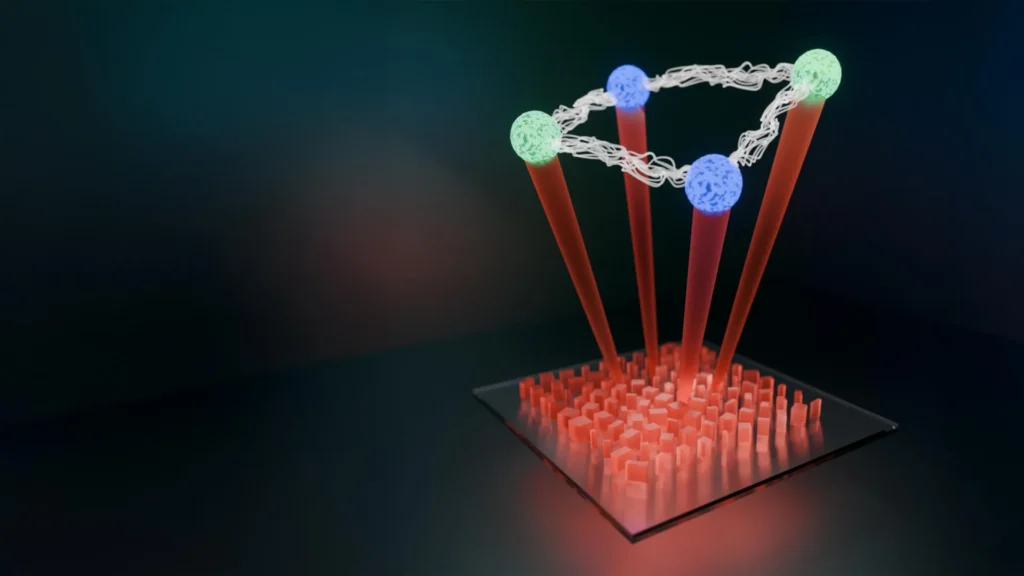In the race toward practical quantum computers and networks, photons — fundamental particles of light — hold intriguing possibilities as fast carriers of information at room temperature. Photons are typically controlled and coaxed into quantum states via waveguides on extended microchips, or through bulky devices built from lenses, mirrors, and beam splitters. The photons become entangled – enabling them to encode and process quantum information in parallel – through complex networks of these optical components. But such systems are notoriously difficult to scale up due to the large numbers and imperfections of parts required to do any meaningful computation or networking.
Could all those optical components could be collapsed into a single, flat, ultra-thin array of subwavelength elements that control light in the exact same way, but with far fewer fabricated parts?
Optics researchers in the Harvard John A. Paulson School of Engineering and Applied Sciences (SEAS) did just that. The research team led by Federico Capasso, the Robert L. Wallace Professor of Applied Physics and Vinton Hayes Senior Research Fellow in Electrical Engineering, created specially designed metasurfaces — flat devices etched with nanoscale light-manipulating patterns — to act as ultra-thin upgrades for quantum-optical chips and setups.
The research was published in Science and funded by the Air Force Office of Scientific Research (AFOSR).
Capasso and his team showed that a metasurface can create complex, entangled states of photons to carry out quantum operations – like those done with larger optical devices with many different components.
“We’re introducing a major technological advantage when it comes to solving the scalability problem,” said graduate student and first author Kerolos M.A. Yousef. “Now we can miniaturize an entire optical setup into a single metasurface that is very stable and robust.”
Metasurfaces: Robust and scalable quantum photonics processors
Their results hint at the possibility of paradigm-shifting optical quantum devices based not on conventional, difficult-to-scale components like waveguides and beam splitters, or even extended optical microchips, but instead on error-resistant metasurfaces that offer a host of advantages: designs that don’t require intricate alignments, robustness to perturbations, cost-effectiveness, simplicity of fabrication, and low optical loss. Broadly speaking, the work embodies metasurface-based quantum optics which, beyond carving a path toward room-temperature quantum computers and networks, could also benefit quantum sensing or offer “lab-on-a-chip” capabilities for fundamental science
Designing a single metasurface that can finely control properties like brightness, phase, and polarization presented unique challenges because of the mathematical complexity that arises once the number of photons and therefore the number of qubits begins to increase. Every additional photon introduces many new interference pathways, which in a conventional setup would require a rapidly growing number of beam splitters and output ports.
Graph theory for metasurface design
To bring order to the complexity, the researchers leaned on a branch of mathematics called graph theory, which uses points and lines to represent connections and relationships. By representing entangled photon states as many connected lines and points, they were able to visually determine how photons interfere with each other, and to predict their effects in experiments. Graph theory is also used in certain types of quantum computing and quantum error correction but is not typically considered in the context of metasurfaces, including their design and operation.
The resulting paper was a collaboration with the lab of Marko Loncar, whose team specializes in quantum optics and integrated photonics and provided needed expertise and equipment.
“I’m excited about this approach, because it could efficiently scale optical quantum computers and networks — which has long been their biggest challenge compared to other platforms like superconductors or atoms,” said research scientist Neal Sinclair. “It also offers fresh insight into the understanding, design, and application of metasurfaces, especially for generating and controlling quantum light. With the graph approach, in a way, metasurface design and the optical quantum state become two sides of the same coin.”
The research received support from federal sources including the AFOSR under award No. FA9550-21-1-0312. The work was performed at the Harvard University Center for Nanoscale Systems

